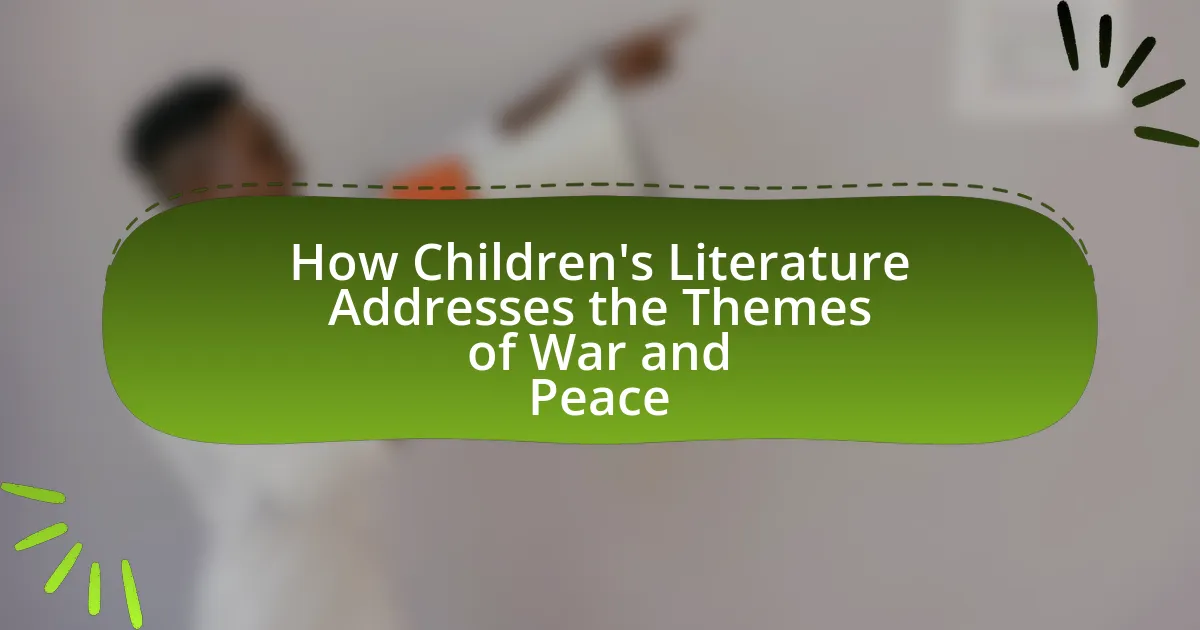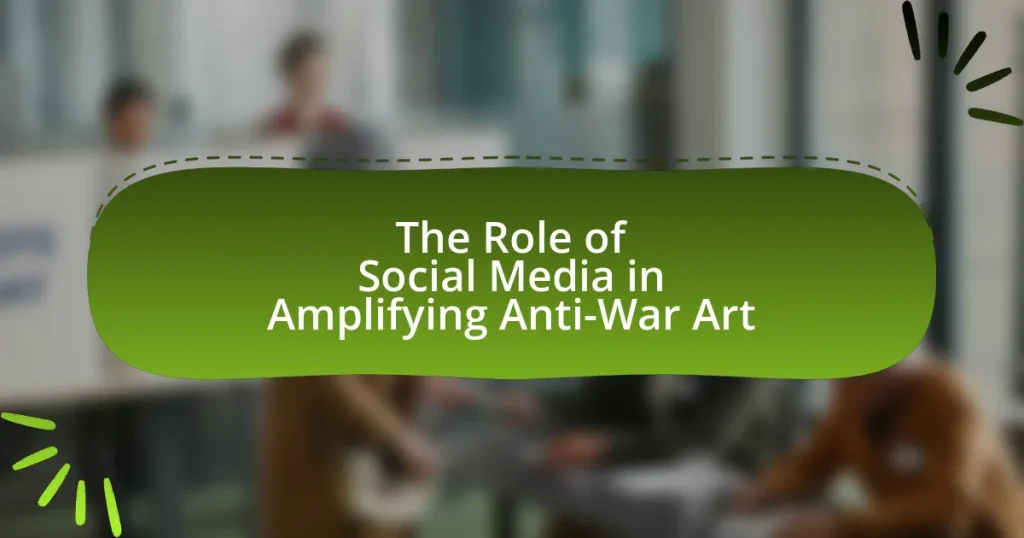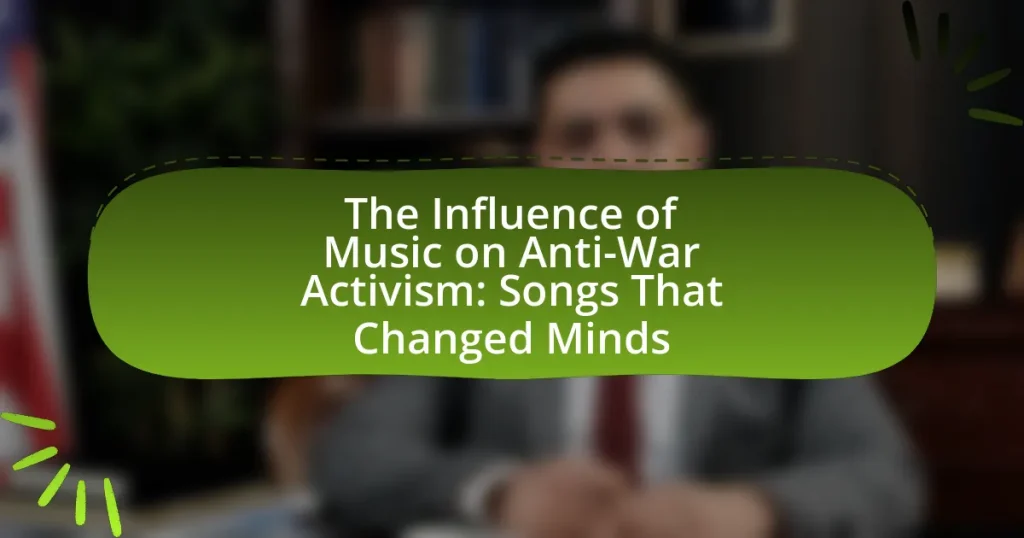Children’s literature plays a significant role in addressing the themes of war and peace by exploring the impact of conflict on individuals, particularly children. The narratives often highlight emotional and psychological effects, showcasing resilience, loss, and the longing for peace through relatable characters and stories. Key themes include the innocence affected by war, the importance of friendship, and the quest for understanding and reconciliation. Authors utilize various storytelling techniques and illustrations to convey complex themes while balancing realism and sensitivity, ultimately fostering empathy and critical thinking in young readers. This literature serves as a vital tool for discussing the complexities of war and peace, enhancing children’s emotional intelligence and social responsibility.
How does Children’s Literature Address the Themes of War and Peace?
Children’s literature addresses the themes of war and peace by presenting narratives that explore the impact of conflict on individuals and communities, often through the eyes of children. These stories frequently depict the emotional and psychological effects of war, illustrating loss, resilience, and the longing for peace. For example, books like “The Breadwinner” by Deborah Ellis highlight the struggles of children in war-torn Afghanistan, showcasing their courage and the desire for a peaceful life. Additionally, literature such as “War Horse” by Michael Morpurgo emphasizes the futility of war and the bonds formed amidst conflict, reinforcing messages of empathy and understanding. Through these narratives, children’s literature serves as a medium for fostering awareness and dialogue about the complexities of war and the importance of peace.
What are the key themes of war and peace in children’s literature?
The key themes of war and peace in children’s literature include the impact of conflict on innocence, the importance of friendship and solidarity, and the quest for understanding and reconciliation. These themes are often explored through narratives that depict the harsh realities of war, such as loss and trauma, while also highlighting the resilience of children and their capacity for empathy. For example, books like “The Breadwinner” by Deborah Ellis illustrate the struggles of a young girl in war-torn Afghanistan, showcasing both the brutality of conflict and the strength found in community and hope. Additionally, stories like “War Horse” by Michael Morpurgo emphasize the bonds formed during wartime, illustrating how relationships can transcend the violence of war and foster peace.
How do authors depict the realities of war in children’s stories?
Authors depict the realities of war in children’s stories by presenting the emotional and psychological impacts of conflict through relatable characters and narratives. These stories often illustrate themes of loss, bravery, and resilience, allowing young readers to understand the complexities of war in a manner appropriate for their age. For instance, in “The Lion and the Unicorn” by Shirley Hughes, the experiences of children during World War II are portrayed, highlighting the fear and uncertainty they face, which reflects historical realities of that time. Such depictions help children process their feelings about war and foster empathy towards those affected by it.
What messages about peace are conveyed through children’s literature?
Children’s literature conveys messages about peace by emphasizing themes of understanding, empathy, and conflict resolution. These narratives often illustrate the importance of communication and cooperation among diverse characters, promoting the idea that peaceful coexistence is achievable through mutual respect and kindness. For example, books like “The Butter Battle Book” by Dr. Seuss highlight the absurdity of conflict and the need for dialogue to resolve differences. Additionally, stories such as “The Peace Book” by Todd Parr explicitly teach children about the various ways to foster peace, including sharing, caring, and being a good friend. These examples demonstrate how children’s literature serves as a tool for instilling values of peace and encouraging young readers to envision a harmonious world.
Why is it important for children to engage with themes of war and peace?
It is important for children to engage with themes of war and peace because it fosters critical thinking and empathy. Exposure to these themes helps children understand complex social issues, historical contexts, and the consequences of conflict. Research indicates that literature addressing war and peace can enhance children’s emotional intelligence, allowing them to better navigate their own feelings and relationships. For instance, studies show that children who read stories about conflict resolution are more likely to develop problem-solving skills and a sense of social responsibility. Engaging with these themes also encourages discussions about morality, justice, and the value of peace, which are essential for developing informed and compassionate citizens.
How can literature shape children’s understanding of conflict?
Literature shapes children’s understanding of conflict by providing narratives that illustrate the complexities of human emotions, relationships, and societal issues. Through stories, children encounter characters facing various conflicts, which helps them develop empathy and critical thinking skills. For instance, books like “The Breadwinner” by Deborah Ellis depict the struggles of a young girl in war-torn Afghanistan, allowing readers to grasp the impact of conflict on individuals and families. Research indicates that exposure to diverse perspectives in literature can enhance children’s ability to understand and navigate real-world conflicts, fostering a sense of compassion and awareness.
What role does empathy play in children’s literature about war and peace?
Empathy serves a crucial role in children’s literature about war and peace by fostering understanding and compassion for diverse perspectives. This literature often presents characters experiencing the impacts of conflict, allowing young readers to connect emotionally with their struggles and resilience. For instance, books like “The Breadwinner” by Deborah Ellis illustrate the harsh realities of war through the eyes of a young girl, promoting empathy by highlighting her courage and the injustices faced by those in conflict zones. Such narratives encourage children to reflect on their own values and the importance of peace, ultimately shaping their worldview and social consciousness.
What are some notable examples of children’s literature that explore these themes?
Notable examples of children’s literature that explore the themes of war and peace include “The Lion, the Witch and the Wardrobe” by C.S. Lewis, which depicts the struggle between good and evil in a war-torn fantasy world, and “Number the Stars” by Lois Lowry, which addresses the impact of World War II on a young girl’s life in Denmark. Additionally, “War Horse” by Michael Morpurgo presents the experiences of a horse during World War I, highlighting the effects of war on both humans and animals. These works illustrate the complexities of conflict and the importance of peace through their narratives and character development.
Which books effectively illustrate the impact of war on children?
Books that effectively illustrate the impact of war on children include “The Kite Runner” by Khaled Hosseini, “A Long Way Gone” by Ishmael Beah, and “War Horse” by Michael Morpurgo. “The Kite Runner” depicts the emotional and psychological scars of war on a young boy in Afghanistan, highlighting themes of guilt and redemption. “A Long Way Gone” provides a firsthand account of a child soldier’s experiences in Sierra Leone, showcasing the brutal realities faced by children in conflict zones. “War Horse” tells the story of a horse and its young owner during World War I, emphasizing the innocence lost and the bond between humans and animals amidst the horrors of war. These books are grounded in real historical contexts, making their portrayals of war’s impact on children both poignant and educational.
How do stories promote messages of reconciliation and peace?
Stories promote messages of reconciliation and peace by illustrating the transformative power of empathy and understanding among conflicting parties. Through narratives that depict characters overcoming differences, stories foster emotional connections that encourage readers to see multiple perspectives. For example, children’s literature often features protagonists who navigate the complexities of conflict, ultimately leading to resolutions that emphasize forgiveness and cooperation. This approach not only engages young readers but also instills values of tolerance and compassion, essential for building peaceful societies. Research indicates that exposure to such narratives can enhance children’s social-emotional skills, making them more likely to engage in peaceful conflict resolution in real life.
How do illustrations and storytelling techniques enhance the themes of war and peace?
Illustrations and storytelling techniques enhance the themes of war and peace by providing visual and narrative depth that evokes emotional responses and fosters understanding. Illustrations can depict the stark realities of conflict, such as destruction and loss, while contrasting images of peace can highlight hope and resilience. For example, in children’s literature like “The Butterfly” by Patricia Polacco, illustrations vividly portray the impact of war on innocent lives, making the theme of peace more poignant and relatable. Storytelling techniques, such as character development and perspective shifts, allow readers to engage with diverse experiences of war and peace, promoting empathy and critical thinking. This combination of visual and narrative elements effectively communicates complex themes, making them accessible to young audiences.
What artistic choices do authors make to convey complex themes?
Authors utilize various artistic choices, such as symbolism, narrative perspective, and character development, to convey complex themes in children’s literature about war and peace. For instance, symbolism allows authors to represent abstract concepts like conflict and resolution through tangible objects or events, making these themes accessible to young readers. Narrative perspective, particularly the use of a child’s viewpoint, enables authors to present the emotional impact of war and peace in a relatable manner, fostering empathy and understanding. Additionally, character development often illustrates the moral dilemmas faced during wartime, allowing readers to explore the consequences of choices made in the context of conflict. These artistic choices effectively engage children with the intricate themes of war and peace, facilitating deeper comprehension and reflection.
How do illustrations influence children’s perceptions of war and peace?
Illustrations significantly influence children’s perceptions of war and peace by shaping their emotional responses and understanding of complex themes. Visual representations in children’s literature can evoke empathy, fear, or hope, guiding young readers to interpret the narratives surrounding conflict and resolution. For instance, studies have shown that illustrations depicting the consequences of war, such as destruction or loss, can lead children to develop a more nuanced understanding of its impact, fostering a sense of compassion for those affected. Conversely, images that highlight peace, cooperation, and community can instill values of harmony and conflict resolution. Research by the International Board on Books for Young People indicates that children exposed to diverse illustrations related to war and peace are more likely to engage in discussions about these themes, enhancing their critical thinking and emotional intelligence.
What challenges do authors face when writing about war and peace for children?
Authors face significant challenges when writing about war and peace for children, primarily due to the need to balance complex themes with age-appropriate content. This includes the difficulty of conveying the harsh realities of war without instilling fear or trauma in young readers. Additionally, authors must navigate the challenge of simplifying intricate political and social issues related to conflict while still providing a meaningful narrative. Research indicates that children’s cognitive and emotional development varies widely, making it essential for authors to tailor their messages to different age groups effectively. For instance, studies show that children aged 6-8 may struggle to understand abstract concepts like justice or peace, requiring authors to use concrete examples and relatable characters to communicate these ideas.
How do authors balance realism and sensitivity in their narratives?
Authors balance realism and sensitivity in their narratives by carefully depicting authentic experiences while considering the emotional impact on their audience. They achieve this through the use of age-appropriate language, relatable characters, and situations that reflect real-life challenges, ensuring that the portrayal of difficult themes, such as war and peace, is accessible without being overwhelming. For instance, authors like Michael Morpurgo in “War Horse” present the harsh realities of conflict through the eyes of a horse, allowing readers to engage with the subject matter in a way that is both truthful and gentle. This approach fosters empathy and understanding, enabling young readers to grasp complex themes while feeling safe and supported in their emotional responses.
What are the potential risks of exposing children to these themes?
Exposing children to themes of war and peace can lead to several potential risks, including desensitization to violence, increased anxiety, and distorted perceptions of conflict. Research indicates that children who are frequently exposed to violent media may become less sensitive to the suffering of others, as shown in studies by the American Psychological Association, which highlight a correlation between media violence exposure and aggressive behavior in youth. Additionally, themes of war can instill fear and anxiety in children, impacting their emotional well-being and leading to issues such as nightmares or heightened stress levels. Furthermore, literature that presents war in a glorified manner may skew children’s understanding of conflict, making them perceive violence as an acceptable solution to problems, as noted in various educational studies on the impact of narrative framing in children’s literature.
How can educators and parents use children’s literature to discuss war and peace?
Educators and parents can use children’s literature to discuss war and peace by selecting age-appropriate books that present these themes in relatable contexts. For instance, stories like “The Butterfly” by Patricia Polacco illustrate the impact of war on families and communities, fostering empathy and understanding. Additionally, literature such as “Peaceful Piggy Meditation” by Kerry Lee MacLean introduces concepts of peace and conflict resolution, providing practical tools for children to navigate their feelings about these complex issues. Research indicates that discussing literature can enhance children’s critical thinking and emotional intelligence, making it an effective medium for exploring sensitive topics like war and peace.
What strategies can be employed to facilitate discussions on these themes?
To facilitate discussions on the themes of war and peace in children’s literature, educators can employ strategies such as guided reading sessions, thematic discussions, and role-playing activities. Guided reading sessions allow children to engage with texts that depict war and peace, fostering comprehension and critical thinking. Thematic discussions encourage students to express their thoughts and feelings about the narratives, promoting empathy and understanding. Role-playing activities enable children to explore different perspectives within the stories, enhancing their ability to relate to characters and situations. These strategies are effective as they create a safe environment for children to explore complex themes, supported by research indicating that interactive and participatory methods enhance learning outcomes in literature education.
How can literature serve as a tool for conflict resolution in educational settings?
Literature can serve as a tool for conflict resolution in educational settings by providing narratives that foster empathy and understanding among students. Through stories that depict diverse perspectives on conflict, literature encourages readers to engage with the emotions and motivations of characters, which can lead to greater awareness of differing viewpoints. For instance, children’s literature often addresses themes of war and peace, allowing students to explore the consequences of conflict and the importance of reconciliation. Research indicates that reading such literature can enhance critical thinking and discussion skills, as students analyze characters’ choices and the outcomes of their actions. This process not only promotes dialogue about conflict but also equips students with the skills to navigate real-life disputes constructively.
What are the best practices for selecting children’s literature that addresses war and peace?
The best practices for selecting children’s literature that addresses war and peace include evaluating the age-appropriateness of the content, ensuring diverse perspectives are represented, and prioritizing narratives that promote empathy and understanding. Age-appropriate literature should be chosen to match the developmental stage of the child, as younger children may require simpler, more abstract representations of conflict, while older children can handle more complex themes. Diverse perspectives are crucial, as they provide a broader understanding of the impacts of war and peace across different cultures and experiences. Literature that fosters empathy, such as stories that highlight personal experiences of conflict and resolution, can help children develop a deeper understanding of these themes. Research indicates that exposure to diverse narratives can enhance children’s social-emotional learning and critical thinking skills, making these practices essential for effective selection.
How can one evaluate the appropriateness of a book’s content for children?
To evaluate the appropriateness of a book’s content for children, one should assess the themes, language, and imagery used in the text. Children’s literature addressing war and peace should present complex themes in a manner that is age-appropriate, ensuring that the content is understandable and relatable for the intended age group. For instance, books should avoid graphic depictions of violence and instead focus on concepts of conflict resolution and empathy. Research indicates that literature can significantly influence children’s understanding of social issues; therefore, selecting books that promote positive values and critical thinking is essential. Additionally, consulting age-specific guidelines from educational organizations can provide further clarity on suitable content for different developmental stages.
What resources are available for finding quality literature on these themes?
Quality literature on the themes of war and peace in children’s literature can be found through several key resources. Academic databases such as JSTOR and Google Scholar provide access to peer-reviewed articles and research papers that analyze children’s literature addressing these themes. Additionally, library catalogs like WorldCat allow users to search for specific titles and authors that focus on war and peace in children’s narratives. Furthermore, organizations such as the International Board on Books for Young People (IBBY) curate lists of recommended books that explore these themes, ensuring that readers can find quality literature. These resources collectively offer a comprehensive foundation for exploring how children’s literature engages with the complex themes of war and peace.



